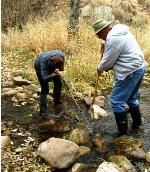In Pipe Technology says its method helps to optimize current wastewater treatment system infrastructure.
The military branch is preparing an environmental impact statement related to its fleet activities in the Atlantic ocean.
Gulf oil spill has devastating effect on qualifying coasts in Mississippi and Alabama.
According to EPA, the Wichita, Kan.-based plant generates significant quantities of hazardous waste, including industrial wastewater treatment filter sludge, primer residue waste containing chromium and cadmium, tetrachloroethylene and trichloroethylene waste from degreasers, and hazardous waste oil.
Hydro Engineering's portable, modular wash rack collects wastewater and oil.
The $190,000 in grants will be used to further education and training for sustainable gardening, hazardous household waste disposal, carbon sequestration, and watershed protection.
After inspecting five construction projects in Maricopa County, Ariz., county officials found particulate matter violations.
The Birmingham, Ala.-based, cast iron pipe manufacturer will answer to 400 violations of environmental laws over the last 10 years with a $4 million fine, $9 million in supplemental projects, and more than $7 million for corrective measures
Thirty-nine candidates completed the Superfund program initiative at Denmark Technical College in Barnwell, S.C.

The Lafayette home of Corey Saft, an architecture professor at the University of Louisiana, will serve as an urban prototype that demonstrates a 90 percent reduction in energy usage over homes built to current code.
A Michigan-based ecologist and ethicist examine the definition and possible interpretations of sustainability.
Effective July 8, a new directive extends to Sept. 30 a yearlong NEP. It specifies programmed inspections in three regions and unprogrammed ones in the other seven OSHA regions.
Company cites need for expeditious review by July 30 to preserve a $200 million federal stimulus grant.
Two EPA staff members will explain how the agency conducted its review and why standards were revised for four contaminants.
The fee structure suggested by two University of California professors covers fixed costs and actual consumption.
The proposed 2011 percentage standards also would require foreign feedstocks to be treated like domestic feedstocks.
China's push to build more sewage treatment plants and otherwise improve water quality call for belt filter presses as well as granular media filters.

Online learning module students demonstrated a 30 percent increase in content knowledge.
Udall, Whitehouse bill would establish regional Centers of Excellence for green infrastructure.
The Ohio River Valley Water Sanitation Commission is responding to a gap in technology while the Kentucky Waterways Alliance voices its concern for the river.